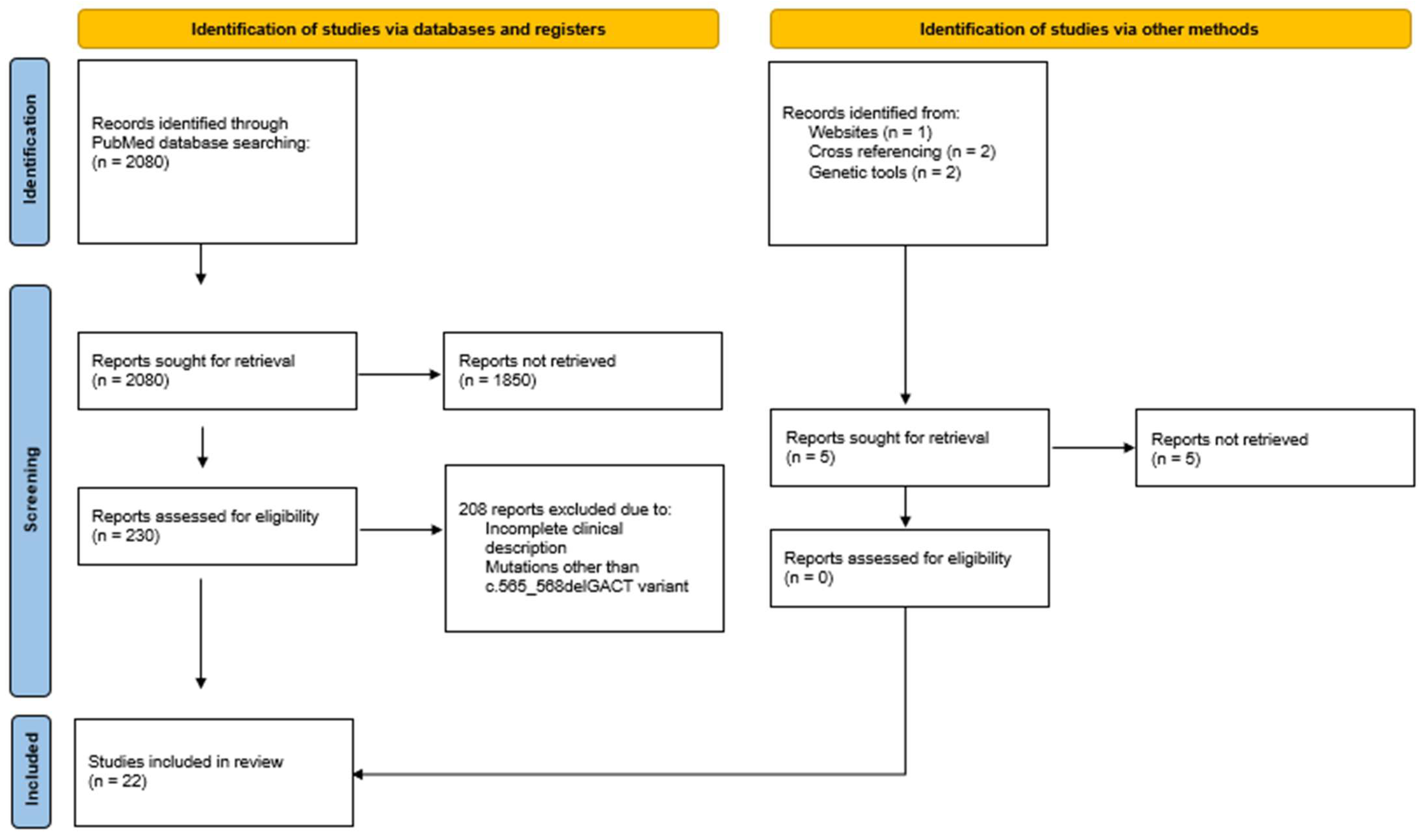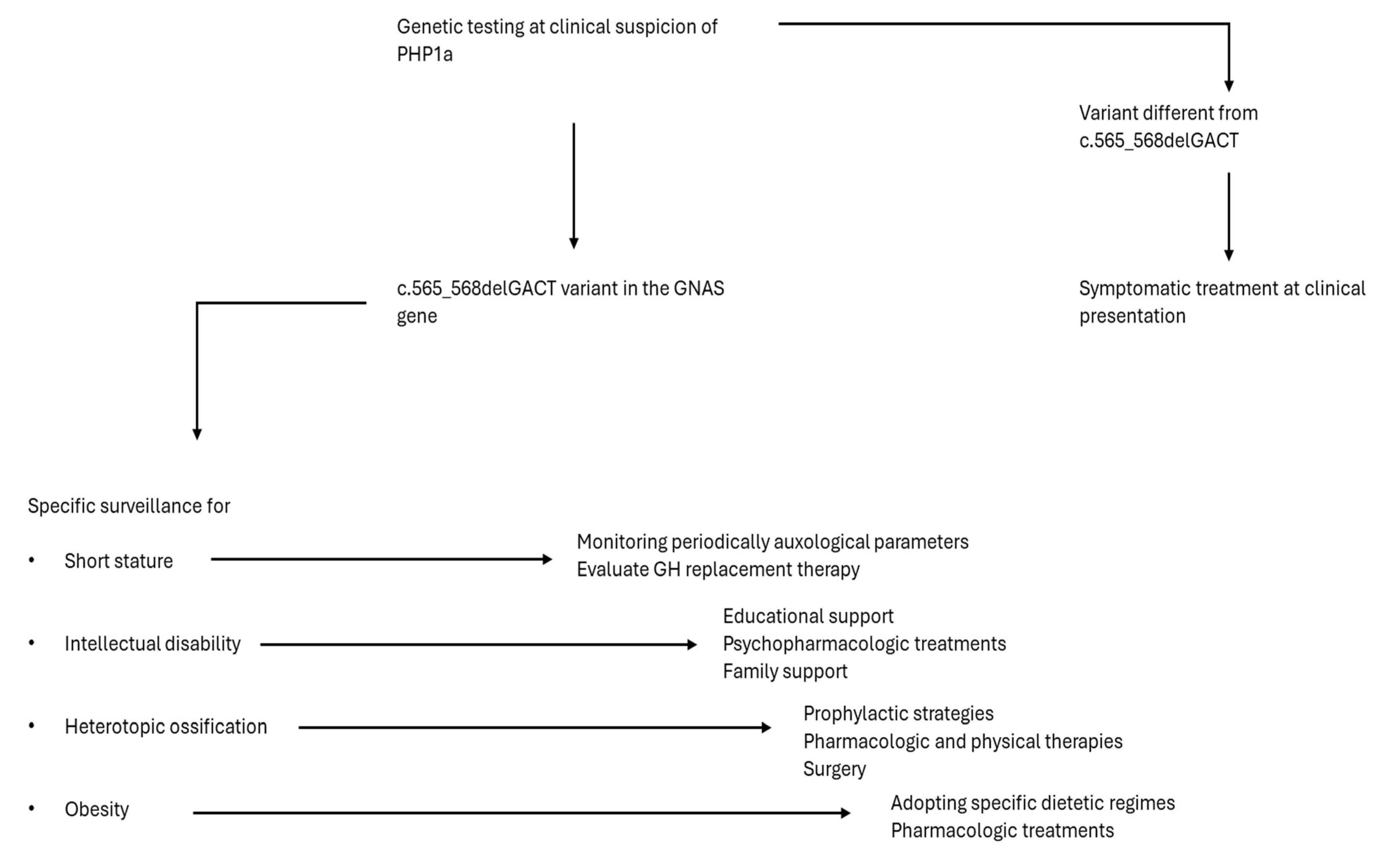Genotype–Phenotype Correlation of GNAS Gene: Review and Disease Management of a Hotspot Mutation
Abstract
:1. Introduction
2. Materials and Methods
2.1. Literature Review
2.2. Genetic Testing
3. Results
3.1. Case Description
3.1.1. Patient 1
3.1.2. Patient 2
3.2. Literature Review
4. Discussion
Author Contributions
Funding
Institutional Review Board Statement
Informed Consent Statement
Data Availability Statement
Conflicts of Interest
References
- Turan, S.; Bastepe, M. GNAS Spectrum of Disorders. Curr. Osteoporos. Rep. 2015, 13, 146–158. [Google Scholar] [CrossRef]
- Tafaj, O.; Jüppner, H. Pseudohypoparathyroidism: One Gene, Several Syndromes. J. Endocrinol. Invest. 2017, 40, 347–356. [Google Scholar] [CrossRef]
- Turan, S. Current Nomenclature of Pseudohypoparathyroidism: Inactivating Parathyroid Hormone/Parathyroid Hormone-Related Protein Signaling Disorder. J. Clin. Res. Pediatr. Endocrinol. 2017, 9, 58–68. [Google Scholar] [CrossRef]
- Mantovani, G.; De Sanctis, L.; Barbieri, A.M.; Elli, F.M.; Bollati, V.; Vaira, V.; Labarile, P.; Bondioni, S.; Peverelli, E.; Lania, A.G.; et al. Pseudohypoparathyroidism and GNAS Epigenetic Defects: Clinical Evaluation of Albright Hereditary Osteodystrophy and Molecular Analysis in 40 Patients. J. Clin. Endocrinol. Metab. 2010, 95, 651–658. [Google Scholar] [CrossRef]
- Mantovani, G.; Spada, A.; Elli, F.M. Pseudohypoparathyroidism and G s α—CAMP-Linked Disorders: Current View and Open Issues. Nat. Publ. Gr. 2016, 12, 347–356. [Google Scholar] [CrossRef]
- Thiele, S.; Mantovani, G.; Barlier, A.; Boldrin, V.; Bordogna, P.; De Sanctis, L.; Elli, F.M.; Freson, K.; Garin, I.; Grybek, V.; et al. From Pseudohypoparathyroidism to Inactivating PTH/PTHrP Signalling Disorder (IPPSD), a Novel Classification Proposed by the EuroPHP Network. Eur. J. Endocrinol. 2016, 175, P1–P17. [Google Scholar] [CrossRef]
- Pollack, I.F. Brain tumors in children. N. Engl. J. Med. 1994, 331, 1500–1507. [Google Scholar] [CrossRef]
- Jiang, S.; Yang, Y.; Song, A.; Wang, O.; Xing, X.; Jiang, Y.; Jiang, Y.; Li, M.; Xia, W.; Nie, M. Genotype-Phenotype Correlations in Pseudohypoparathyroidism Type 1a Patients: A Systemic Review. Eur. J. Endocrinol. 2023, 189, 103–111. [Google Scholar] [CrossRef]
- Delinière, A.; Haddad, C.; Herrera-Siklódy, C.; Hermida, A.; Pruvot, E.; Bressieux-Degueldre, S.; Millat, G.; Janin, A.; Hermida, J.S.; Asatryan, B.; et al. Phenotypic Characterization of Timothy Syndrome Caused by the CACNA1C p.Gly402Ser Variant. Circ. Genomic Precis. Med. 2023, 16, 280–282. [Google Scholar] [CrossRef]
- Martone, S.; Buonagura, A.T.; Marra, R.; Rosato, B.E.; Del Giudice, F.; Bonfiglio, F.; Capasso, M.; Iolascon, A.; Andolfo, I.; Russo, R. Clinical Exome-Based Panel Testing for Medically Actionable Secondary Findings in a Cohort of 383 Italian Participants. Front. Genet. 2022, 13, 1–8. [Google Scholar] [CrossRef]
- Mormile, I.; Russo, R.; Andolfo, I.; de Paulis, A.; Rossi, F.W.; Rendina, D. Rheumatoid Arthritis and Osteogenesis Imperfecta: Is There a Genetic Causal Association? Osteoporos. Int. 2022, 33, 2233–2235. [Google Scholar] [CrossRef]
- Richards, S.; Aziz, N.; Bale, S.; Bick, D.; Das, S.; Gastier-Foster, J.; Grody, W.W.; Hegde, M.; Lyon, E.; Spector, E.; et al. Standards and Guidelines for the Interpretation of Sequence Variants: A Joint Consensus Recommendation of the American College of Medical Genetics and Genomics and the Association for Molecular Pathology. Genet. Med. 2015, 17, 405–424. [Google Scholar] [CrossRef] [PubMed]
- Tavtigian, S.V.; Harrison, S.M.; Boucher, K.M.; Biesecker, L.G. Fitting a Naturally Scaled Point System to the ACMG/AMP Variant Classification Guidelines. Hum. Mutat. 2020, 41, 1734–1737. [Google Scholar] [CrossRef]
- Richard, N.; Molin, A.; Coudray, N.; Rault-guillaume, P.; Jüppner, H.; Kottler, M. Paternal GNAS Mutations Lead to Severe Intrauterine Growth Retardation (IUGR) and Provide Evidence for a Role of XLαs in Fetal Development. J. Clin. Endocrinol. Metab. 2013, 98, 1549–1556. [Google Scholar] [CrossRef]
- Meyers, C.; Lisiecki, J.; Miller, S.; Levin, A.; Fayad, L.; Ding, C.; Sono, T.; McCarthy, E.; Levi, B.; James, A.W. Heterotopic Ossification: A Comprehensive Review. JBMR Plus 2019, 3, e10172. [Google Scholar] [CrossRef]
- Xu, Y.; Huang, M.; He, W.; He, C.; Chen, K.; Hou, J.; Huang, M.; Jiao, Y.; Liu, R.; Zou, N.; et al. Heterotopic Ossification: Clinical Features, Basic Researches, and Mechanical Stimulations. Front. Cell Dev. Biol. 2022, 10, 1–13. [Google Scholar] [CrossRef]
- Bagnasco, F.; Di Iorgi, N.; Roveda, A.; Gallizia, A.; Haupt, R.; Maghnie, M. Prevalence and Correlates of Adherence in Children and Adolescents Treated with Growth Hormone: A Multicenter Italian Study. Endocr. Pract. 2017, 23, 929–941. [Google Scholar] [CrossRef] [PubMed]
- Smeets, C.C.J.; Zandwijken, G.R.J.; Renes, J.S.; Hokken-Koelega, A.C.S. Long-Term Results of GH Treatment in Silver-Russell Syndrome (SRS): Do They Benefit the Same as Non-SRS Short-SGA? J. Clin. Endocrinol. Metab. 2016, 101, 2105–2112. [Google Scholar] [CrossRef] [PubMed]
- Shaki, D.; Hershkovitz, E.; Tamam, S.; Bollotin, A.; David, O.; Yalovitsky, G.; Loewenthal, N.; Carmon, L.; Walker, D.; Nowak, R.; et al. GH Treatment in Pediatric Down Syndrome: A Systematic Review and Mini Meta-Analysis. Front. Endocrinol. 2023, 14, 1–9. [Google Scholar] [CrossRef]
- Seo, G.H.; Yoo, H.W. Growth Hormone Therapy in Patients with Noonan Syndrome. Ann. Pediatr. Endocrinol. Metab. 2018, 23, 176–181. [Google Scholar] [CrossRef]
- Ertl, D.A.; De Nanclares, G.P.; Jüppner, H.; Hanna, P.; Pagnano, A.; Pereda, A.; Rothenbuhler, A.; Del Sindaco, G.; Ruiz-Cuevas, P.; Audrain, C.; et al. Recombinant Growth Hormone Improves Growth and Adult Height in Patients with Maternal Inactivating GNAS Mutations. Eur. J. Endocrinol. 2023, 189, 123–131. [Google Scholar] [CrossRef]
- Schöneberg, T.; Schulz, A.; Biebermann, H.; Hermsdorf, T.; Römpler, H.; Sangkuhl, K. Mutant G-Protein-Coupled Receptors as a Cause of Human Diseases. Pharmacol. Ther. 2004, 104, 173–206. [Google Scholar] [CrossRef]
- Kõks, S. Genomics of Wolfram Syndrome 1 (WFS1). Biomolecules 2023, 13, 1–12. [Google Scholar] [CrossRef]
- Kõks, S.; Soomets, U.; Paya-Cano, J.L.; Fernandes, C.; Luuk, H.; Plaas, M.; Terasmaa, A.; Tillmann, V.; Noormets, K.; Vasar, E.; et al. Wfs1 Gene Deletion Causes Growth Retardation in Mice and Interferes with the Growth Hormone Pathway. Physiol. Genom. 2009, 37, 249–259. [Google Scholar] [CrossRef]
- Kõks, S.; Soomets, U.; Plaas, M.; Terasmaa, A.; Noormets, K.; Tillmann, V.; Vasar, E.; Fernandes, C.; Schalkwyk, L.C. Hypothalamic Gene Expression Profile Indicates a Reduction in G Protein Signaling in the Wfs1 Mutant Mice. Physiol. Genom. 2011, 43, 1351–1358. [Google Scholar] [CrossRef]
- Kalinovic, R.; Pascariu, A.; Vlad, G.; Nitusca, D.; Sălcudean, A.; Sirbu, I.O.; Marian, C.; Enatescu, V.R. Involvement of the Expression of G Protein-Coupled Receptors in Schizophrenia. Pharmaceuticals 2024, 17, 1–11. [Google Scholar] [CrossRef]
- Fröhlich, A.; Pfaff, A.L.; Middlehurst, B.; Hughes, L.S.; Bubb, V.J.; Quinn, J.P.; Koks, S. Deciphering the Role of a SINE-VNTR-Alu Retrotransposon Polymorphism as a Biomarker of Parkinson’s Disease Progression. Sci. Rep. 2024, 14, 1–13. [Google Scholar] [CrossRef]
- Azam, S.; Haque, M.E.; Jakaria, M.; Choi, D.-K.; Jo, S.-H.; Kim, I.-S.; Choi, D.-K. G-Protein-Coupled Receptors in CNS: A Potential Neurodegenerative Disorders and Associated. Cells 2020, 9, 506. [Google Scholar] [CrossRef]



| Clinical Features | Prevalence Regardless of the Mutation Type (According to [8] | Prevalence in LOF Variants with PVS1 or PVS1_Strong Strength Levels [8] | Prevalence in the GNAS c.565_568delGACT Variant |
|---|---|---|---|
| Hypocalcemia | 54.3% | 57.8% | 47% |
| Hyperphosphatemia | 60.1% | 63.0% | 42% |
| PTH increased | 80.0% | 85.9% | 64% |
| TSH resistance | 75.5% | 75.8% | 100% |
| GHRH resistance | 18.0% | 19.0% | 69% |
| LH/FSH resistance | 6.3% | 6.1% | 6% |
| AHO clinical features | 87.5% | 88.7% | |
| Brachydactyly | 59.2% | 58.1% | 74% |
| Short stature | 25% | 24.2% | 44% |
| Intellectual disability | 28.8% | 28.7% | 69% |
| Round face | 33.2% | 39.1% | 71% |
| Obesity | 52.8% | 55.7% | 53% |
| Subcutaneous ossifications | 39.1% | 52.3% | 61% |
Disclaimer/Publisher’s Note: The statements, opinions and data contained in all publications are solely those of the individual author(s) and contributor(s) and not of MDPI and/or the editor(s). MDPI and/or the editor(s) disclaim responsibility for any injury to people or property resulting from any ideas, methods, instructions or products referred to in the content. |
© 2024 by the authors. Licensee MDPI, Basel, Switzerland. This article is an open access article distributed under the terms and conditions of the Creative Commons Attribution (CC BY) license (https://creativecommons.org/licenses/by/4.0/).
Share and Cite
Cipriano, L.; Ferrigno, R.; Andolfo, I.; Russo, R.; Cioffi, D.; Savanelli, M.C.; Pellino, V.; Klain, A.; Iolascon, A.; Piscopo, C. Genotype–Phenotype Correlation of GNAS Gene: Review and Disease Management of a Hotspot Mutation. Int. J. Mol. Sci. 2024, 25, 10913. https://doi.org/10.3390/ijms252010913
Cipriano L, Ferrigno R, Andolfo I, Russo R, Cioffi D, Savanelli MC, Pellino V, Klain A, Iolascon A, Piscopo C. Genotype–Phenotype Correlation of GNAS Gene: Review and Disease Management of a Hotspot Mutation. International Journal of Molecular Sciences. 2024; 25(20):10913. https://doi.org/10.3390/ijms252010913
Chicago/Turabian StyleCipriano, Lorenzo, Rosario Ferrigno, Immacolata Andolfo, Roberta Russo, Daniela Cioffi, Maria Cristina Savanelli, Valeria Pellino, Antonella Klain, Achille Iolascon, and Carmelo Piscopo. 2024. "Genotype–Phenotype Correlation of GNAS Gene: Review and Disease Management of a Hotspot Mutation" International Journal of Molecular Sciences 25, no. 20: 10913. https://doi.org/10.3390/ijms252010913








